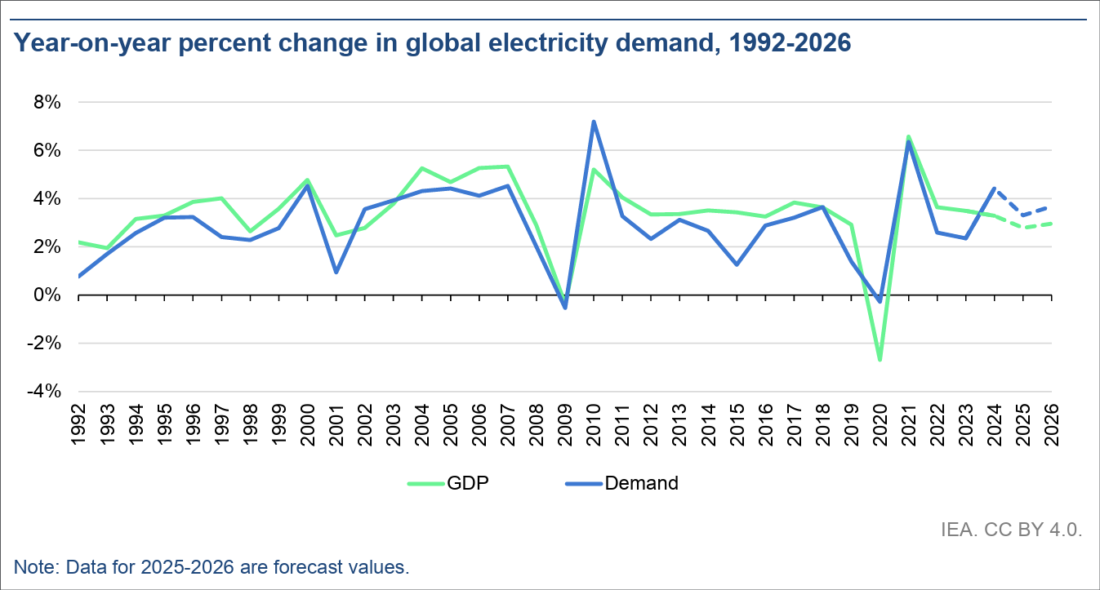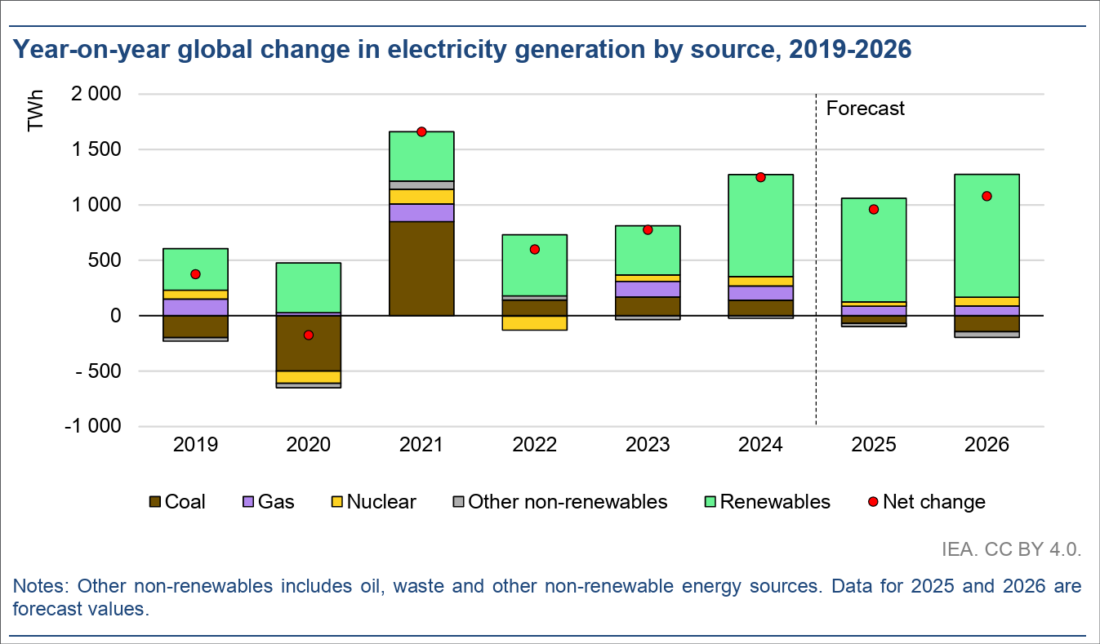On July 30, the International Energy Agency (IEA) released a new report “Electricity Mid-Year Update 2025.” In this report IEA indicates that renewables are expected to overtake coal as the world’s largest source of electricity as early as 2025 or by 2026 at the latest, depending on conditions.
Global electricity demand continues to increase
IEA finds that electricity demand is set to rise by 3.3% in 2025 and 3.7% in 2026. The majority of new electricity demand will come from emerging economies in Asia, but IEA also expects U.S. electricity demand to increase due to the rapid expansion of data centers.
China and India are expected to drive 60% of the increase in global electricity consumption over 2025 and 2026. By contract, consumption in the European Union is set to grow more slowly this year, at around 1%, though a modest acceleration is expected in 2026, the report shows.

Renewables are expected to overtake coal
Electricity demand is growing much faster than in the last ten years. 90% of the increase in global electricity demand in 2025 is expected to be covered by renewable energy (wind and solar). Renewables (wind, solar, hydro, bioenergy, geothermal) are expanding rapidly and, depending on economic conditions such as weather and fuel price trends, they are expected to overtake coal as the world’s largest source of electricity as early as 2025 or by 2026 at the latest.
Solar PV and wind energy are central to this shift, with their combined share of global electricity generation forecast to grow from 15% in 2024 to 17% in 2025, to above 19% by 2026. Solar PV is forecast to grow by 27% in 2026 while coal-fired generation is expected to remain broadly stable. Looking at electricity supply, renewable energy is projected to account for 36% of global electricity generation, driven by the expansion of renewables in China and the EU, particularly the growth of solar and wind power. Meanwhile, coal-fired power is expected to fall below 33% of total electricity generation, the lowest share in the past 100 years.
However, the report notes that the growth of renewable energy will vary considerably from one region to another. For example, total electricity generation from renewable power sources increased by 11% in the US in the first half of 2024. However, renewable energy generation is expected to grow by only 2% year-on-year in Europe by the end of 2025. Nevertheless, the share of “low-emission sources” in the energy mix of European countries is expected to exceed 75% by 2026, up from 71% in 2024. (Figure below : IEA forecasts that global coal-fired generation will decline very slightly by around 0.5% in 2025, following growth of 1.3% in 2024.)

Power sector emissions are plateauing in 2026
Global carbon dioxide (CO2) emissions from electricity generation will peak in 2025 with a slight decline in 2026, as coal-fired power generation starts to decline by 2026 while nuclear and gas power generation will reach the highest on record.
Global emissions from electricity generation rose by 1.2% in 2024. The record-breaking heat in 2024 led to increased air conditioning usage, which in turn caused a rise in electricity demand. Nevertheless, growth in power sector emissions showed signs of slowing down as rapid deployment of renewables constrained increases in fossil-fired generation. As this trend continues, the IEA expects emissions in 2025 to plateau and remain relatively unchanged, with a slight decline of less than 1% in 2026.
The European Union follows China with substantial declines in emissions from power generation over the 2025-2026 period. US power sector emissions are expected to decline only slightly over the same period. By contrast, emissions in India and Southeast Asia will continue to rise as coal-fired generation grows at a significant pace.
Wholesale electricity prices rose in some regions
Average wholesale electricity prices in the first half of 2025 rose year-on-year in various regions, including Europe, the U.S. and Japan. By contrast, countries such as India and Australia saw lower wholesale prices compared to the previous year. According to the IEA, wholesale electricity prices in Japan were up by about 15% year-on-year in the first half of 2025, averaging USD 76/MWh. The rise in LNG prices increased generation costs, applying upward pressure on wholesale prices. Warmer than average temperatures in the spring and early summer heatwaves, combined with a cold winter, also contributed to higher electricity prices. Futures prices indicate a rise in wholesale electricity prices in 2026, to an average of USD 87/MWh.
IEA
Press Release: Global electricity demand to keep growing robustly through 2026 despite economic headwinds
Electricity Mid-Year Update 2025 (Report)
Written/published by: International Energy Agency (IEA)
Published: July 30, 2025
Additional Note: U.S. threatens IEA, suggesting withdrawal ?
It is clear that expanding renewable energy offers significant economic benefits in addition to its low environmental impact. However, the Trump administration tries to reverse various measures of its predecessor and move toward expanding fossil fuels, particularly LNG. The Trump team criticized wind power generation and halted a program initiated by the previous Biden administration to promote solar power generation. The Trump administration has successively canceled funding and loan guarantees for renewable energy projects, putting the brakes on these initiatives. Furthermore, to prepare for potential power supply disruptions caused by the scaling back of renewable projects, the administration has issued the orders to extend operation of thermal power plants that are planned to be closed. Thus, the possibility of increased CO2 emissions in the U.S. cannot be ruled out. In addition, according to the U.S. media, the Trump administration claims that the IEA is hindering investment in fossil fuels by suggesting the Net-Zero scenario and emphasising the need for decline of fossil fuel and the expansion of renewables. It also demanded that the IEA replace its No. 2 official (Deputy Executive Director Mary Warwick) with someone aligned with Trump administration policies, and suggested that the U.S. may withdraw from the organization if its demand is not met.
In response to this request from the Trump administration, the IEA stated in the 2025 edition of the “World Energy Outlook,” it will have a wide spectrum of possible output implied by current markets and policies into its scenarios. It is important to note how the standoff with the U.S. will affect the IEA’s future scenario analysis.
